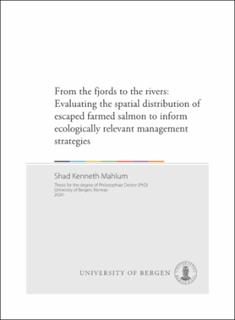| dc.contributor.author | Mahlum, Shad Kenneth | |
| dc.date.accessioned | 2020-04-28T06:20:08Z | |
| dc.date.available | 2020-04-28T06:20:08Z | |
| dc.date.issued | 2020-05-08 | |
| dc.date.submitted | 2020-04-22T15:01:28.613Z | |
| dc.identifier | container/1a/b3/8c/c6/1ab38cc6-8a97-470d-8560-30474422dc99 | |
| dc.identifier.uri | http://hdl.handle.net/1956/22026 | |
| dc.description.abstract | Over the last 40 years, the relatively fast expansion of Atlantic salmon aquaculture has created new obstacles for the persistence of wild Atlantic salmon stocks where the two overlap. Now, the greatest threat to existing wild Atlantic salmon populations is the unintended release of domesticated Atlantic salmon from aquaculture sites. Once escaped, domesticated Atlantic salmon can migrate into rivers and spawn with wild salmon populations. Overall, the hybridization of wild and domesticated salmon has negative impacts that threatens the long-term viability of many salmon populations. However, researchers have limited knowledge into the mechanics that promote the direct overlap between the two conspecifics and thus stakeholders lack robust and effective mitigation strategies and are largely dependent on reactive measures to control escaped Atlantic salmon. This thesis was focused on the spatial distribution and overlap of wild and escaped farmed Atlantic salmon and identifying ecologically sound mitigation and management strategies to control the abundance of escaped Atlantic salmon in nature. To accomplish this, the thesis is divided into four objectives: 1) evaluate the movement patterns of acoustically tagged wild adult Atlantic salmon throughout the estuaries and connected fjords where salmon directly overlap with aquaculture sites. 2) validate the spawning count data collected during fall snorkel surveys to quantify the abundance of wild and escaped salmon during active spawning activities. Finally, using validated data from the spawning count surveys, assess the 3) among- and 4) within river distribution of wild and escaped Atlantic salmon. My results demonstrated the direct spatial overlap of wild and escaped Atlantic salmon and fills the following knowledge gaps necessary for the effective management of escapees in rivers: 1) when relying on reactive mitigation efforts (e.g., active removals from the river), monitoring and removal methods that fail to account for the within river spatial variation of escaped Atlantic salmon can be limited in their effectiveness to quantify and remove escapees and should only be used when alternate mitigation efforts fail (e.g., proactive management strategies), 2) to implement effective marine protected areas, it is necessary to either incorporate a) the habitat where direct interactions between wild and escaped farmed salmon are most likely to occur or b) the spatial scopes that aquaculture concessions has the greatest effect on escapee abundance (75 km from important rivers), and 3), it is recommended that the current regulation of aquaculture production (e.g., traffic light system) should be expanded to include regulating concession limits to reduce the number of escaped farmed salmon in important Atlantic salmon rivers. This thesis highlights the importance of understanding spatial distribution and the mechanisms that drive the direct overlap of wild and escaped farmed salmon so that robust ecologically based tools can be developed for resource managers to help regulate the abundance of escaped Atlantic in the wild. | en_US |
| dc.language.iso | eng | eng |
| dc.publisher | The University of Bergen | en_US |
| dc.relation.haspart | Paper I: Mahlum, S. K., Skoglund H., Wiers T., Norman E.S., Barlaup B.T., Wennevik, V., Glover, K. A., Urdal K., Bakke G., Vollset K.W (2019). Swimming with the fishes: validating drift diving to identify farmed Atlantic salmon escapees in the wild. Aquaculture Environment Interactions 11: 417-427. The article is available at: <a href="http://hdl.handle.net/1956/22016" target="blank">http://hdl.handle.net/1956/22016</a> | en_US |
| dc.relation.haspart | Paper II: Mahlum, S. K., K. W. Vollset, B. T. Barlaup, G. Velle, T. Wiers (2018). Where the salmon roam: fjord habitat use of adult Atlantic salmon. ICES Journal of Marine Science 75:2163-2171. The article is not available in BORA due to publisher restrictions. The published version is available at: <a href="https://doi.org/10.1093/icesjms/fsy071" target="blank">https://doi.org/10.1093/icesjms/fsy071</a> | en_US |
| dc.relation.haspart | Paper III: Mahlum, S. K., K. W. Vollset, B. T. Barlaup, H. Skoglund, G. Velle. Salmon on the lam: Drivers of escaped farmed fish abundance in rivers. The article is not available in BORA. | en_US |
| dc.relation.haspart | Paper IV: Mahlum, S. K., K. W. Vollset, B. T. Barlaup, H. Skoglund, G. Velle. The last stop: Longitudinal distribution of farmed escaped Atlantic salmon in rivers. The article is not available in BORA. | en_US |
| dc.rights | Attribution-NonCommercial (CC BY-NC) | eng |
| dc.rights.uri | https://creativecommons.org/licenses/by-nc/4.0/ | eng |
| dc.title | From the fjords to the rivers: Evaluating the spatial distribution of escaped farmed salmon to inform ecologically relevant management strategies | en_US |
| dc.type | Doctoral thesis | |
| dc.date.updated | 2020-04-22T15:01:28.613Z | |
| dc.rights.holder | Copyright the Author. | en_US |
| dc.contributor.orcid | 0000-0002-2663-2677 | |
| fs.unitcode | 12-60-0 | |

